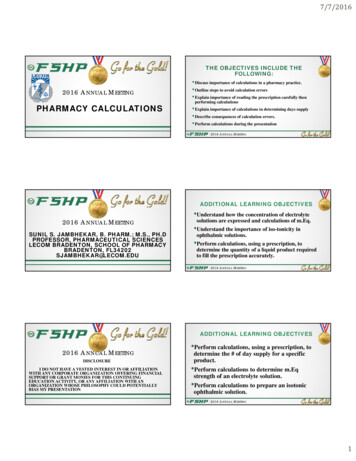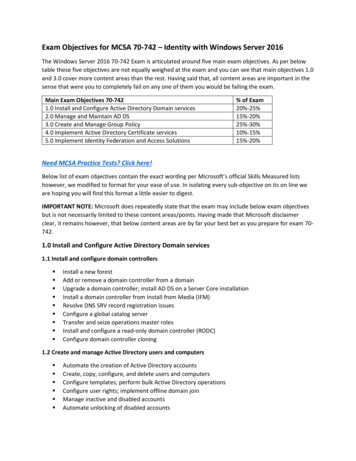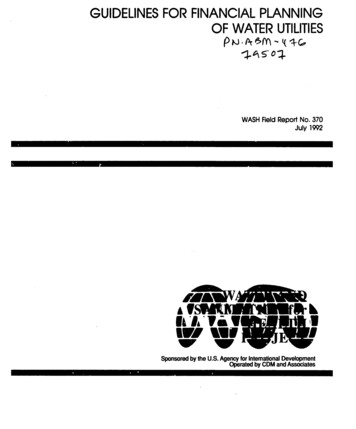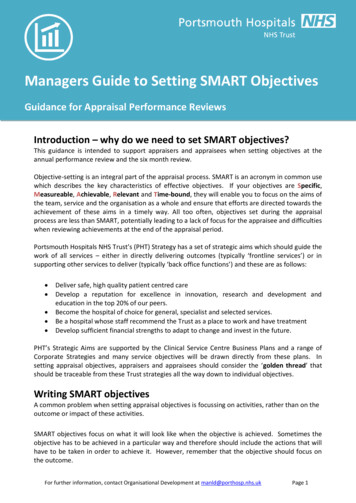
Transcription
7/7/2016THE OBJECTIVES INCLUDE THEFOLLOWING:2016 ANNUAL MEETINGPHARMACY CALCULATIONS Discuss importance of calculations in a pharmacy practice. Outline steps to avoid calculation errors Explain importance of reading the prescription carefully thenperforming calculations Explain importance of calculations in determining days supply Describe consequences of calculation errors. Perform calculations during the presentation2016 ANNUAL MEETING4ADDITIONAL LEARNING OBJECTIVES2016 ANNUAL MEETINGSUNIL S. JAMBHEKAR, B. PHARM.; M.S., PH.DPROFESSOR, PHARMACEUTICAL SCIENCESLECOM BRADENTON, SCHOOL OF PHARMACYBRADENTON, FL34202SJAMBHEKAR@LECOM.EDU Understand how the concentration of electrolytesolutions are expressed and calculations of m.Eq. Understand the importance of iso-tonicity inophthalmic solutions. Perform calculations, using a prescription, todetermine the quantity of a liquid product requiredto fill the prescription accurately.2016 ANNUAL MEETING5ADDITIONAL LEARNING OBJECTIVES2016 ANNUAL MEETINGDISCLOSUREI DO NOT HAVE A VESTED INTEREST IN OR AFFILIATIONWITH ANY CORPORATE ORGANIZATION OFFERING FINANCIALSUPPORT OR GRANT MONIES FOR THIS CONTINUINGEDUCATION ACTIVITY, OR ANY AFFILIATION WITH ANORGANIZATION WHOSE PHILOSOPHY COULD POTENTIALLYBIAS MY PRESENTATION Perform calculations, using a prescription, todetermine the # of day supply for a specificproduct. Perform calculations to determine m.Eqstrength of an electrolyte solution. Perform calculations to prepare an isotonicophthalmic solution.2016 ANNUAL MEETING61
7/7/2016IMPORTANCE OF CALCULATIONS INTHE PHARMACY PRACTICE: It is consistent with the practice and philosophyof pharmaceutical care. Patient safety is of utmost importance. Your pharmacy is the last check point for theprescription written by a physician. Therefore,pharmacy team is responsible for all the finalchecks.2016 ANNUAL MEETING7 The final check points will include accuracy of the dose and dosage regimen; the quantity prescribed or required; # of refills; and # of days supply. Your Pharmacists depend on you to input theprescription accurately to avoid editing andsave time. Insurance companies will reimburse you oryour employer only for the quantity written onthe prescription and not for the quantitydispensed.2016 ANNUAL MEETING10Electrolytes ConcentrationIts solution contains ions.Examples include,sodium chloride, calcium chloride, potassium chloride,zinc sulfate, magnesium sulfate, and many more.Electrolytes dissociate into particles known as ions. Forexample,NaCl ------ Na (cation) Cl- (anion)These ions carry electric charge2016 ANNUAL MEETING8 The internal and external audit is another goodreason for maintaining accuracy of theprescription. Federal and state regulations will also play animportant role. When there is a reimbursement issue, accuracyin the quantity of the medication dispensedbecomes an important matter.2016 ANNUAL MEETING11Electrolyte ions (cations) commonly present in the bloodinclude:sodium (Na ), potassium (K ), calcium (Ca ),magnesium (Mg ), etc.The anions commonly found in the blood are Chloride(Cl-), bicarbonate (HCO3--), phosphate (HPO4--), andsulfate (SO4--).These ions maintain acid-base balance in the body.9122
7/7/2016 Electrolyte solutions are, therefore, used in the treatmentFor example: Potassium chloride (KCl)Molecular weight 74.5 gramsof disturbances in the electrolytes. The concentrations of these solutions can be can beEquivalent weight 74.5 gramsexpressed as % W/V or mg %; however, these expressionsdo not take into consideration chemical equivalence and,hence, they do not give any direct information as to thenumber ions or charges they carry. A chemical unit, mili-equivalent (m.Eq.) is almostPotassium (K ) 39 grams and chloride (Cl-) 35.5gramsTherefore, 39 35.5 74.5 grams74.5/1000 0.0745 grams or 74.5 mgsexclusively used to express the concentration of anelectrolyte in solution.Therefore, 74.5 milligrams of KCl 1 m.Eq of KCl149 milligrams of KCl 2 m.Eq of KCl1316For Calcium Chloride (CaCl2.2H2O) This unit is related to the number of ionic charges insolution and the valence of ions or m.Eq unit is ameasurement of the amount of chemical activity of anelectrolyte. Under normal conditions, blood plasma contains 155m.Eq of cations and same number of anions. The total concentration of cations always equals the totalconcentration of anions.14Molecular weight 147 gramsIts equivalent weight is Molecular weight/total valence (2)Equivalent weight 147/2 73.5 grams and 73.5grams/1000 0.0735 grams or 73.5 mgs.Therefore, 73.5 mg of calcium chloride represent 1 mEqof calcium chloride (CaCl2.2H2O) and 147.0 mg ofcalcium chloride (CaCl2.2H2O) represent 2 m.Eq ofcalcium chloride17The expression mEq represents the amount of solute inmg equal to 1/1000 th gram of the equivalent weight ofthe substance.Equivalent weight (grams)1 mEq Two Tables in your handout provide values for someimportant cations and anions.---------------------------------100015183
7/7/2016IonsValenceAt. weightmEq. (mg)Na K Ca Mg NH4 Li 1122112339402418723392012187 Patient will need 74.5 mg/mEq. x 15 mEq. X 2/day 2235 mg of potassium chloride daily Potassium chloride is available as 10% w/v (i.e., 10g/100 ml or 10,000 mg/100 mL) or 100 mg/mL 100 mg of KCl is provided by 1 mL of 10% w/vpotassium chloride solution 1117.5 mg (15 mEq.) will be provided by X mL ofsolution19IonsValenceAt. weightmEq. 0.097.048.0SO4- HCO3CO3- H2PO4HPO4- -22 1117.5 mg/100 mg/mL 11.175 mL of 10% w/v solution will provide 15mEq. of potassium chloride 11.175 mL x 2/day 22.35 mL per day x 21 days 469.35 ml quantity for 3 weeks Sig: 11.175 ml by mouth twice a day for threeweeks20POTASSIUM CHLORIDE PRESCRIPTIONIsotonic SolutionPotassium chloride liquidA solution that has same osmotic pressure as body fluids.Sig: 15 mEq;po;bid;for 3 weeksDis; QS23Hypotonic SolutionRefill x2Potassium chloride is available as 10% w/v solutionA solution that has lower osmotic pressure than the bodyfluid.Molecular weight of potassium chloride is 74.5 gramsHypertonic SolutionTherefore 74.5 mg (Molecular weight in milligrams isequal to 1 mEq. for monovalent compounds)A solution that has higher osmotic pressure than that ofbody fluids.21244
7/7/2016 It has been determined that 0.9% w/v solution ofsodium chloride exhibits same osmotic pressure as thehuman body fluids Therefore, while preparing solution to be administeredin the body (ophthalmic solution and intravenoussolutions), it is imperative that these solutions havesame osmotic pressure as body fluid or as 0.9% sodiumchloride solution. Therefore, most frequently, sodium chloride is used tomake solution isotonic. Boric acid and dextrose mayalso be used when it is necessary.255
Li 17 7 19 Ions Valence At. weight mEq. (mg) Cl-1 35.5 35.5 SO4--2 96.0 48.0 HCO3-1 61.0 61.0 CO3--2 60.0 30.0 H2PO4-1 97.0 97.0 HPO4--2 96.0 48.0 20 POTASSIUM CHLORIDE PRESCRIPTION Potassium chloride liquid Sig: 15 mEq;po;bid;for 3 weeks Dis; QS Refill x2 Potassium chloride is available as 10% w/v solution Molecular weight of potassium .











